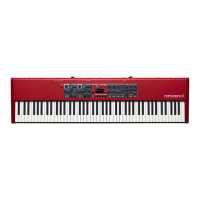
Do you have a question about the nord piano 5 88 and is the answer not in the manual?
| Type | Stage Piano |
|---|---|
| Number of Keys | 88 |
| Piano Library | Nord Piano Library |
| Polyphony | 120 Voices |
| Display | OLED |
| Weight | 18.5 kg (40.8 lbs) |
| Sound Engine | Nord Piano Engine |
| Effects | Reverb, EQ |
| Audio Outputs | 2 x 1/4" (L/Mono, R) |
| Headphones | 1 x 1/4" |
| MIDI I/O | MIDI In, MIDI Out |
| USB | Type B |
| Pedal Inputs | Sustain |
| Dimensions | 1286 x 111 x 366 mm (50.6 x 4.4 x 14.4 inches) |
| Power Supply | AC Power Adapter |
Keep the safety instructions for future reference to ensure safe operation of the equipment.
Basic precautions when using electric products, including reading instructions and avoiding water exposure.
Specific warnings against naked flames and operation in tropical climates.
Highlights the key features of the Nord Piano 5, including its keybed and sound capabilities.
Information on the nordkeyboards.com website for updates, software, and library sounds.
Details on how to access and read the user manual, including PDF format.
Details on obtaining free sounds and creating custom samples using provided software.
A brief overview of the different sections of the Nord Piano 5 control panel.
Overview of the piano sounds, layers, and pedal features available on the instrument.
Overview of the sample synth sounds, layers, and sound shaping capabilities.
Overview of program management and the available effects processing.
Instructions on how to connect the Nord Piano 5 and power it on safely.
Explanation of the panel controls, including dials, knobs, and buttons.
How to select, edit, and store programs on the Nord Piano 5.
Instructions on using and understanding the Live Mode feature for instant program saving.
Steps to activate effects and assign them to specific sound engines or layers.
Guidance on combining sounds from the Piano and Sample Synth sections.
Instructions on setting up keyboard splits and gradual cross-fade transitions between sounds.
Managing Piano Layer A/B, combining sounds, and KB Split configurations.
Adjusting piano sound levels, octave shifts, and sustain pedal functionality.
Information on the organization and selection of different piano sound types.
Overview of different piano sound sizes and their impact on memory.
Using List View and Type/Model selection for finding piano sounds.
Adjusting piano tone using Layer Detune and Touch sensitivity settings.
Details on the different pickup combinations available for Clavinet sounds.
Explanation of String Resonance and Soft Release effects for acoustic pianos.
Details on using the Nord Triple Pedal for sustain, half-pedaling, and sostenuto.
Adjusting piano tone using Timbre settings for acoustic and electric pianos.
Controlling volume, octave shifts, and sustain for Sample Synth sounds.
Information about the available sample synth instruments and sound libraries.
Details on how monophonic sample instruments function, especially with legato.
Methods for selecting sample instruments by category or alphabetically.
Adjusting Dynamics, Envelope, Timbre, Unison, and Vibrato for sample instruments.
Procedures for storing edited programs and assigning names.
Switching display views and adjusting program-specific transposition.
Configuring mono output and setting keyboard split points.
Adjusting the transition width for sounds across split points.
Using the program dial and selecting navigation modes like Numeric Pad.
Using Live Programs for instant saving and the Panic function for note off.
Utilizing program select buttons and understanding what a program contains.
How to enter and navigate the various system and sound configuration menus.
Methods for reorganizing programs within banks using Swap and Move functions.
How to enable effects and assign them to specific sound layers.
Details on Mod 1 effects like Tremolo, Auto Pan, and Wah.
Using a control pedal with Mod 1 and exploring Mod 2 effects like Phaser and Flanger.
Details on Amp/Comp simulation, drive, and compression effects.
Using the 3-band equalizer to shape the tone, including Mid frequency sweep.
Configuring delay time, feedback, and using Tempo Tap.
Exploring different reverb types, Chorale variation, and Bright/Dark modes.
Understanding MIDI functions, channel assignment, and connections.
Steps for recording Nord Piano 5 performances to sequencers or DAWs.
Overview of MIDI messages, including Program Change, and their operation.
Managing Local Control settings and using the Panic function for note termination.
Configuration options for Memory Protect, Global Transpose, Fine Tune, and Version Info.
Adjusting Piano Pedal Noise Level and Piano String Resonance Level.
Configuring Local Control, MIDI Channel, Control/Program Change, Transpose MIDI, and Velocity Curve.
Setting the type of connected sustain pedal for correct operation.
Configuring connected expression pedals and adjusting their gain.
Overview of the Nord Sound Manager application for organizing and backing up instrument content.
Specifies the operating system and driver requirements for using the Nord Sound Manager.
Introduction to the Sample Editor 3 for creating custom playable sample instruments.
Details the operating system and driver requirements for the Nord Sample Editor 3.
Guide to connecting headphones, line outputs, and monitor inputs.
Information on connecting the Nord Piano 5 to a computer via USB for MIDI and updates.
Details on connecting sustain pedals and expression/control pedals.
Explanation of the MIDI IN and MIDI OUT 5-pin DIN connectors.